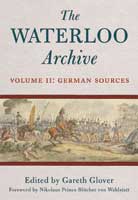Book
Review:
The Waterloo Archive: German Sources
Edited
by Gareth Glover
 For
too long we've been only offered British accounts of the great
battle of Waterloo and, as history lovers, we have missed out
on some telling experiences of German troops there.
For
too long we've been only offered British accounts of the great
battle of Waterloo and, as history lovers, we have missed out
on some telling experiences of German troops there.
They
were a large part of the Allied army and served in forces including
those of Hanover, Brunswick, Nassau and, of course, the King's
German Legion.
Some
of those men were unfairly accused of not doing as well as British
troops, but in The Waterloo Archive: German Sources we
get to see the contribution made by the German-speaking troops.
Journals
and diary notes from soldiers in dozens of regiments make up the
The Waterloo Archive: German Sources and its wide-reaching
view is one of its great strengths.
In
addition, many of the sources have never been published in English
before and so offer readers a rich new look at warfare in the
Napoleonic era.
There were details from Major von Dreves, of the Osnabruck Landwehr,
who described Colonel Hugh Halkett capturing General Cambronne
of the French Imperial Guard.
It
was during the retreat from Waterloo and the general had been
organising a rearguard when the colonel forced his way through
French skirmishers to grab the enemy officer and haul him, fighting,
back to his lines.
"A
French general (whose name I believe was Cambronne) was energetically
engaged in attempting to halt and reform the battalions.
"He
succeeded several times; but their retiring continued however,
as they were forcefully driven back by our pursuing battalions.
"Our
brigadier, the then Col Halkett, had observed that action and,
with unequalled intrepidity, rode through the French skirmishers,
who covered the retreating columns, to that general and, with
great luck, brought him back before the entire line, through the
enemy skirmishers, and made him his pirsoner, notwithstanding
(the man's) forceful resistance."
Rifleman
Friedrich Lindau's narrative is amazing. He was serving with Colonel
Ompteda's KGL brigade and was helping to defend La Haye Sainte
during Waterloo.
During
the massive rainstorm that struck the night before the fighting
Lindau was ordered not into the dry of the buildings but to camp
in the orchard.
"Which
did not please me at all because I could not find a single dry
spot."
Lindau
tells of the fierce firefight between the French and his comrades,
how the attackers grabbed at their rifles through the loopholes
and the desperate shortage of ammunition.
Eventually
they had to surrender and were robbed by the French and some wounded
were killed.
Some
time later they escaped while their captors plundered a barn and
soon came across Prussian uhlans who took them to a nearby village
where they recovered from their exertions.
Lindau
had
a good friend called Harz who had been unable to sleep on the
night before Waterloo because he had dreamed he had died, shot
through the body.
Lindau
told him not to mind such stuff but during the battle Harz was
killed, shot through the body.
One
amusing part of his tale is that he mentions a woman from Hamelin
whose surname was Pieper.
The
cavalry and artillery are also covered in The
Waterloo Archive: German Sources.
I
read with interest General William Dornberg's description of dealing
with a regiment of cuirassier that had been advancing at the trot
between Allied artillery and infantry squares.
Only
having light cavalry at hand, Dornberg ordered two regiments to
stay in column and hit the French heavies on each flank as they
came on. The plan worked a treat and the cuirassiers were seen
off.
On
a subsequent attack by the armour-clad French, Dornberg was run
through the lung with a sword.
"As
blood was coming out of my mouth and my speaking was much impaired,
I had to ride off to the rear."
So
matter of fact and without the histrionics we would get nowadays.
The
Waterloo Archive: German Sources offers many such instances
that bring alive the battle of Waterloo and the very important
part that Wellington's German allies played in winning the fight.
Included
in sections on the various regiments are details of officers killed
and wounded and the number of casualties the units suffered.
A
great addition to our Napoleonic knowledge.
8.5/10
-
Richard Moore